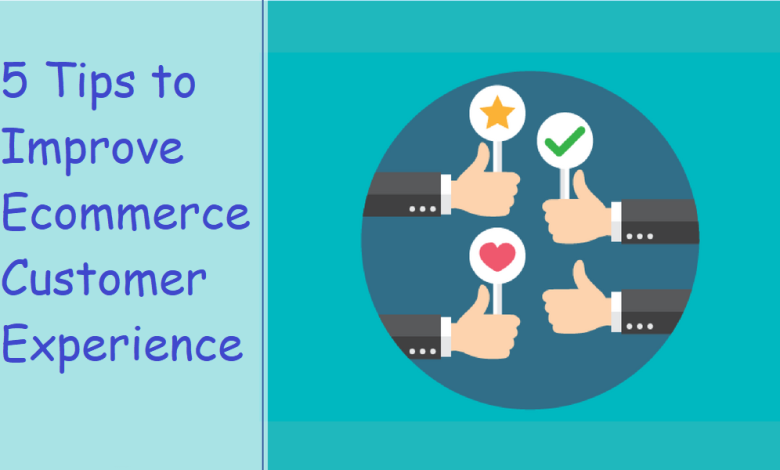5 Tips to to Improve Ecommerce Customer Experience

In ecommerce, customer experience is everything. If you succeed in providing your customers a good experience on your ecommerce store, they will not only end up buying from you but also come to you for all their future needs. Customers who have a good experience with a store also tend to recommend it to their friends. More often than not, people who hear praise about something from a trusted friend try that themselves.
Why is Customer Experience Important?
In today’s highly competitive marketplace, loyal customers are vital for e-commerce businesses. Customers who experience satisfaction during their online shopping become advocates for your brand and will promote it to others as a result. Online shoppers have an array of options when it comes to selecting a product.
Having an online store is a great way to build a brand, but if you do not offer the customers something more than just a product, you will lose a large part of the market, and you will have to pour additional resources into areas such as promotion, sales, special offers, marketing, all of which can be very costly for your business. Because of this, increasingly more businesses are investing their time and resources in the design of a customer experience map that will generate word-of-mouth advertising and marketing, increase revenue, and create satisfied customers.
Studies show that loyal clients increase revenue by over 300 percent over the course of three years. As opposed to dissatisfied customers, whose complaints can reduce your revenues by up to 14% within a calendar year.
How to Improve Customer Experience?
But how to provide a good experience to your customers? Although there is a lot you can do, a few fundamentals have a significant impact on customer experience. This article lists 5 of the most important tips that will get your customers to complete their purchase happily and come out of your store ready to convince their friends to visit.
-
User friendly website
Your ecommerce store is the face of your business. It should make a good first impression the moment customers enter it. It should look professional, appealing, and reliable. Apart from its visual appearance, it should be easy to use. Customers who already know what they are looking for should be provided with an efficient and AI powered search bar where they can enter the keyword to find their required product. Customers who don’t know what they are looking for should find it easy to navigate through different pages of your store. For this, all the products should be properly organized under relevant categories and sub-categories. The navigation menu should be prominent and simple. In other words, your ecommerce store should not only look good but also work well.
2. Provide personalization
Our psychology is such that we are more at ease at familiar places and with familiar people. Or even if the place and people are unfamiliar, we quickly feel at home when they get a little personal and informal. Leverage this psychological factor and make your customers feel at home in your ecommerce store by providing personalization.
One way to do this is to write your web copy in an informal and personal style using the second person pronouns. Another way to achieve personalization is to display your content in the customer’s local language and to allow them to pay in their local currency. This is a great customer experience booster as customers are more comfortable in their native language and prefer to pay in their local currency. You can use different tools to change your store’s language and currency according to the customer’s GeoIP location. If you have a multi-lingual Magento 2 store, you can use the Magento 2 hreflang tags tool to display content in the language the customer uses to search your product in search engine.
3. Improve product page
Once a visitor lands on your product page, it is this page that either turns him into a customer or make him quit. If you really want your customers to convert, your product page must be compelling. The product description, features, images, video, ‘Add to Cart”, pricing, etc. must be clear. Provide as much information about the product as possible so that customers are left with no doubts or questions. Add an FAQ’s section so that customers can find answer to any question they might have. Provide customer reviews to add authenticity to your product.
4. One page checkout
Nothing is more frustrating for customers than a complex and long checkout process. Once a customer has added a product to the cart, he wants the checkout process to be as quick and smooth as possible. According to a report, more than 80% of customers abandon a website if they find the checkout process long. The more hindrances he faces in this step, the more unlikely he is to complete the purchase. Make a one page checkout and avoid distractions. One of the main distractions is the necessity to create an account. Forcing customers to create an account in order to complete their checkout is what greatly annoys customers. Offer guest checkout so that customers who shop at your store for the first time can complete their purchase without any impediment. And of course, offer more than one payment option.
5. Include a live chat system
Customers can come in need of support at any step of their sale’s journey. They might need to ask a question about your product’s specific feature or need help in making payment. Providing instant and efficient help can secure the sale. Integrate a live chat software into your store and dedicate a support person who should be available 24/7. Customers who need any help can ask question in real time and a real support agent is there to answer them. If you just tell your customers to call a specific number or drop an email for help, they most likely won’t do that. They want quick answers otherwise they will leave the store.
The importance of a live chat software can be better understood by this example. Imagine you are shopping in a shoe store and one shoe catches your attention. You try it but it’s tight and want one size up but there is no one around to ask to bring you that specific size. You wait for a minute or two but no one comes. Now you start wondering whether this pair of shoes is really the one you want and need. You also start thinking about going somewhere else. Ultimately, you drop the idea of buying from this store and leave.
Conclusion:
You really need to focus on your store’s customer experience if you want to reduce your bounce rate. A good customer experience is essential to keep your business running. Without a good customer experience, you might survive temporarily but not in the long run in this competitive market. If you apply the above mentioned tips properly, you will see an obvious increase in your customer base and a significant drop in abandonment.
A customer experience strategy for eCommerce is as crucial to the continued success of your business as a marketing strategy. Hopefully, this post has helped you understand the importance of improving the customer experience on eCommerce websites and given you some useful suggestions.



